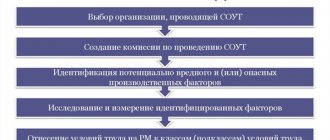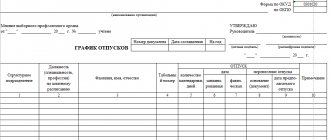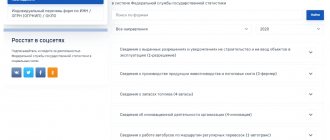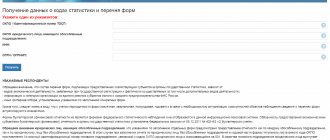According to the provisions of Federal Law No. 426-FZ of December 28, 2013, all employers are required to conduct a special assessment of working conditions at the workplaces available in their companies. This condition is necessary to respect the rights of employees to receive reliable information about the conditions of their work, including in situations where they may have a negative impact on their health and ability to work.
What should be understood by SOUT
A special assessment of working conditions is a whole complex of measures carried out one after another aimed at identifying dangerous and/or harmful factors in the production environment and assessing the degree of their impact on the employee, taking into account the actual values of their deviations from the standards approved by the Government of the Russian Federation for the organization of safe working conditions.
Federal Law dated December 28, 2013 No. 426-FZ classifies almost all workplaces at enterprises, organizations, firms into a category for which it is mandatory to evaluate the working conditions provided to employees according to a special scheme, with the exception of the following cases.
For which categories of employees is it allowed not to carry out a special procedure for assessing the provided working conditions for employees (clause 3, article 3 of the Federal Law of December 28, 2013 No. 426-FZ)
- employees working remotely;
- workers working from home (homeworkers);
- workers whose employers are not individual entrepreneurs;
- workers whose employers are religious organizations.
In addition, there is a legally established list of individual places of work in enterprises with certain types of activities that have specific properties, for which a special procedure must also be carried out to assess the proposed working conditions for workers (Resolution of the Government of the Russian Federation dated April 14, 2014 No. 290 ). Carrying out a special procedure for assessing the impact of working conditions on an employee in such cases is carried out taking into account those features that are established by the authorized body of the federal executive power.
List of enterprises (departments) that carry out certain types of activities, when conducting a special procedure for assessing the impact of working conditions of workplaces on employees where the features established by the federal executive body apply:
- Vessels:
– sea;
– river;
– inland navigation vessels;
- engaged in fishing.
- Civil aviation vessels.
- Organizations providing emergency (specialized) care.
- Intensive care units, intensive care units, operating rooms.
- Departments of medical institutions for performing diagnostics and direct treatment using special medical equipment (instruments, devices, equipment, etc.).
- Organizations that prepare for sports competitions.
- Media, theaters, circuses, etc.
- Enterprises with nuclear and radiation hazardous industries.
- Enterprises related to organizing the work of divers.
- Enterprises whose activities are carried out in the field of extreme exposure to the gas environment and air environment.
- Enterprises associated with underground work.
- City passenger transport.
- Medical departments providing assistance to patients with mental disorders.
- Enterprises that operate in the areas of manufacturing, testing, processing, disposal and storage of explosives.
EXAMPLE No. 2
At the enterprise, four watchmen work in the “every day after three” mode (four workers replace each other, only one worker works at the workplace). In this case, when conducting an SOUT, the list of workplaces at which the SOUT will be carried out (hereinafter referred to as the list) should reflect only one workplace where four people work. Errors are often made when including in the list places with the same name, where workers use the same equipment, work in the same work areas and premises, and non-stationary workplaces, especially if these workplaces use shift work. In these cases, the same principle applies - the number of jobs corresponds to the number of simultaneously working workers.
What happens if the company does not carry out SOUT
According to SOUT expert, researcher at the central laboratory for examining working conditions at the All-Russian Research Institute of Labor of the Ministry of Labor, Natalya Byshova, it is more profitable for an employer to carry out SOUT than to ignore it, since otherwise he will face a number of financial sanctions.
Carefully reading the legislation (from Part 2 of Article 5.27.1 of the Code of Administrative Offenses) we can see that organizations (enterprises, firms, etc.) that ignored the implementation of special assessment and assessment procedures may be subject to penalties in the amount of 50.0 to 80, 0 thousand rub. In addition, already in the current year, 2021, the employer will not have legal grounds to provide employees with compensation for work with harmful working conditions, since they are accrued only based on the results of a special assessment.
Tax deductions due for the payment of workers' compensation will not be available to an employer who has not conducted a SAW on its enterprise.
The employer’s responsibilities also include indicating in the employment contract with the employee or in an annex to it in the form of an additional one, the working conditions of what level of safety correspond to a specific workplace, the basis for which can only be the results of the conducted special labor safety assessment. These violations entail new fines and amount to 80.0 thousand rubles. It won't work anymore. The amount of fines will significantly exceed the specified amount.
And in any case, if it is discovered that there is no SAW, the employer will be required to carry it out and, accordingly, spend money on it.
Compiling a list of jobs for special assessment
To compile a list of positions for which a special assessment of working conditions should be carried out, the employer is obliged to form a special commission .
It must include:
- representative of the company;
- occupational safety specialist;
- representatives of a trade union organization or other structure that represents the interests of workers at the enterprise.
Paragraph 1, Article 9, 426-FZ specifies that the number of commission members should be odd - this will facilitate the decision-making process by voting.
The first and main task of the commission is to compile a list of all positions in the company and then exclude from it those that are not subject to special assessment in accordance with Article 3, 426-FZ. After this, the commission members face another serious operation: they need to determine which of the objects included in the list are similar.
This is very important for the company, since, in accordance with Article 16 of the regulatory document we are interested in, a special assessment of working conditions can be carried out only on 20% of them.
It is clear that this can significantly simplify the procedure itself and reduce its cost. However, the employer must carefully ensure that it does not violate the established rules for performing a special assessment using this simplified procedure, since otherwise the results of the special assessment may be invalidated and it will have to be carried out again.
EXAMPLE No. 4
As part of the proceedings in cases No. 33-4199/2015 and No. A59-2617/2015), the judicial authorities come to the conclusion that the implementation of the special assessment and assessment process is incomplete due to the lack of assessment assessment materials for some positions present in the staffing table (appeal ruling of the Astrakhan Regional Court dated 7 December 2015 in case No. 33-4199/2015, decision of the Fifth Arbitration Court of Appeal dated December 14, 2015 in case No. 05AP-9269/2015).
To avoid mistakes, it is necessary to carefully check the correspondence of job titles in the staffing table, employment contracts and SOUT materials.
There is another problem when conducting SOUT. In order to optimize business processes, many organizations carry out restructuring, which is inevitably accompanied by changes in job titles, sometimes completely insignificant. However, a change in position does not lead to a significant change in job responsibilities and working conditions. In this regard, many employers make an unreasonable decision not to conduct an unscheduled special labor assessment, despite the fact that the job titles in the special labor assessment materials do not correspond to the new staffing table and employment contracts.
What the discrepancy between the staffing table and SOUT materials leads to, as well as the incorrect combination of jobs can be considered in the following example in the framework of the trial in case No. A59-2617/2015 (decision of the Fifth Arbitration Court of Appeal dated December 14, 2015 in case No. A59-2617 /2015).
Storage and modifications
The special assessment card for working conditions is kept by the employer, usually in the personnel department. Storage is carried out for five years, that is, until the next certification. The document is presented at the request of management and supervisory authorities.
Changes and additions are not made to the SOUT map, since periodic assessment work is required in the following cases:
- After five years, the next certification is carried out.
- If changes have been made to the technical process or new equipment has been purchased, then experts must be involved in the assessment again within 6 months.
- When organizing a workplace, certification is carried out again after a year.
No changes are made to the special assessment card for the conditions of the labor process; the document is drawn up again. This is a requirement of regulations and regulatory documents.
Stage 3. Getting ready for SOUT
It is necessary to notify all departments of the company about the upcoming workplace assessment and provide inspectors with access to all premises. If we talk about the office, the main parameter here is illumination . Therefore, you should make sure that all lamps are working properly. If employees use computer equipment (and monitors are a source of harmful radiation), you need to prepare documents for it.
Note! The surface of the working table must be illuminated in accordance with the hygienic standards of SanPiN. Without taking into account the light from a table lamp, the illumination standard is 300 lux . If it is a little smaller, about 260-280 lux, you can organize combined lighting, that is, install a table lamp.
Stage 4. We participate in measurements and eliminate shortcomings along the way
When everything is ready, specialists from the assessing organization must walk around the premises and check the workplaces, measuring the influence of harmful factors. In this case, one of the members of the SOUT commission must be present. It is recommended to draw up a table in which to enter the workplaces being checked and make notes.
In each room, experts make a staff seating plan and assign a serial number to each workplace. Working conditions in an office are assessed primarily in terms of the lighting of the place. Therefore, experts check : the height of the ceiling in the room, the power of the overhead lighting, the level of illumination without taking into account daylight (depending on the time of year, measurements are taken in the early morning or with the windows curtained).
By carrying out SOUT in the office, the appraiser’s specialists often allow the defects to be corrected on the spot. For example, the illumination of the workplace can be improved by installing more powerful lamps or adding light sources. As a result, job class outcomes will improve.
In what cases will an unscheduled inspection be carried out according to the SOUT?
In accordance with paragraph 69 of the order of the Ministry of Labor and Social Protection of the Russian Federation dated October 30, 2012 No. 354n, the grounds for authorized officials of Rostrud and its territorial bodies to carry out an unscheduled inspection of compliance by a legal entity or individual entrepreneur with mandatory requirements are:
- expiration of the deadline for the employer to fulfill the order to eliminate the identified violation of the requirements of labor legislation and other regulatory legal acts containing labor law norms;
- receipt by Rostrud or its territorial body of: appeals and statements from citizens, including individual entrepreneurs, legal entities, information from state authorities, local governments, trade unions, from the media about facts of violations by employers of the requirements of labor legislation and other regulatory legal acts containing labor law standards, including labor protection requirements, which entailed a threat of harm to the life and health of workers, as well as leading to non-payment or incomplete payment on time of wages, other payments due to employees, or the establishment of wages in the amount less than the amount provided for by the labor legislation of the Russian Federation;
- an employee’s appeal or statement about the employer’s violation of his labor rights;
- an employee’s request to conduct an inspection of labor conditions and safety at his workplace;
- availability of orders from the head (deputy head) of Rostrud to conduct an unscheduled inspection, issued in accordance with the instructions of the President of the Russian Federation or the Government of the Russian Federation, or the head (deputy head) of the territorial body of Rostrud, issued on the basis of the prosecutor’s request to conduct an unscheduled inspection as part of supervision of execution laws on materials and appeals received by the prosecutor's office.
How to fill it out correctly
All information received by specialists after analyzing the selected workplaces is entered into the SOUT map. This document is a special form of a standard form, it must be filled out according to certain requirements. The data entry process consists of several stages.
- A cap
Frequency of special assessment of working conditions
In this part of the document you should indicate the full name of the enterprise, the address of its actual location, the full name of the manager and email address. The following codes must also be entered:
- TIN;
- OKPO;
- OKOGU;
- OKVED;
- OKATO.
- Number and information about employees
The document is assigned a number in the order for which a specific line is intended. The name of the structural unit is also indicated according to the staffing table. In the field “Issue of ETKS, EKS” the details of the unified tariff and qualification directories are entered, on the basis of which this schedule was compiled. The number of employees must be current at the time of the audit.
- SNILS
The insurance numbers of the individual personal account of all employees who are currently on staff should be indicated here. SNILS of newly hired employees must also be included in the document after they are hired.
- Equipment used
This field is intended for entering information that characterizes the equipment used in this production. Not only its name must be indicated, but also its model and number. This data can be found in the documents for this technology. The materials used for the work must also be indicated.
- Harmful and dangerous factors
All information to be included in this part of the document is provided by the organization that was hired to conduct the assessment of working conditions. Many organizations provide such services, but it is better to choose a trusted company. Data can be entered either by the specialist who conducted the research or by a member of the commission.
- Guarantees and compensation
This contains information about what benefits, guarantees and compensations should be provided to workers if they work in hazardous work. It is mandatory to indicate the clause in the legislation that obliges this.
- Recommendations
Important! Based on the results of the inspection, the EHS commission can make proposals to minimize the harmful effects on workers from their activities.
The entire list of necessary activities, including repairs, must be included in the map. If there are no such proposals, the word “No” is put.
Before conducting an inspection, the manager must issue an appropriate order to conduct it.
Inspection order - sample
Also, a separate document must indicate the stages of its implementation.
Order on verification stages - sample
Important! All entered data must be reliable and current at the time of filling.
How can I find out about SOUT inspections?
In addition to automated inspections, the State Labor Inspectorate organizes inspections:
- planned;
- unscheduled.
Rostrud organizes inspections in accordance with the order of the Ministry of Labor and Social Protection of the Russian Federation dated October 30, 2012 No. 354n “On approval of the Administrative Regulations for the execution by the Federal Service for Labor and Employment of the state function of exercising federal state supervision over compliance with labor legislation and other regulatory legal acts, containing labor law norms.”
According to Art. 9 of the Federal Law of December 26, 2008 No. 294-FZ “On the protection of the rights of legal entities and individual entrepreneurs in the exercise of state control (supervision) and municipal control” the subject of a scheduled inspection is compliance by a legal entity, individual entrepreneur in the process of carrying out activities with mandatory requirements and requirements established by municipal legal acts, as well as compliance of the information contained in the notification of the commencement of certain types of business activities with mandatory requirements.
Scheduled inspections are carried out no more than once every three years.
Scheduled inspections are carried out on the basis of annual plans developed by state control (supervision) bodies and municipal control bodies in accordance with their powers.
The final stage
No later than 3 days after the end of the assessment, copies of the approved report are sent to the expert organization, and the declaration is sent to the labor inspectorate within 30 days. A scanned copy of the title page is sent by mail with a notification and by e-mail to Occupational Safety and Health Certification Service LLC.
After all reports and declarations have been sent to the relevant government bodies, the management of the enterprise is obliged to familiarize employees in writing with the special assessment cards. Within 30 days, the approved action plan to improve working conditions and a summary statement are posted on the company’s website.






